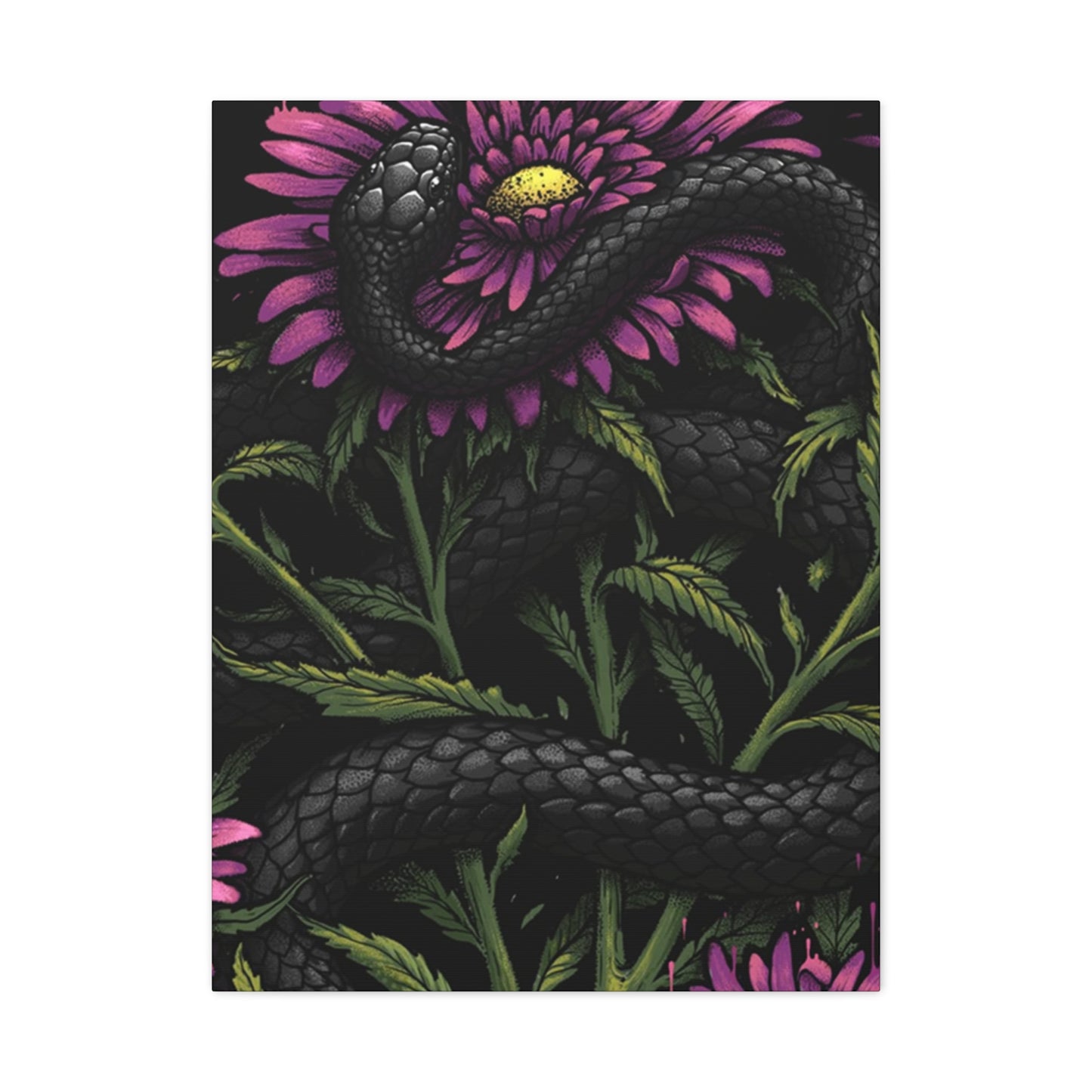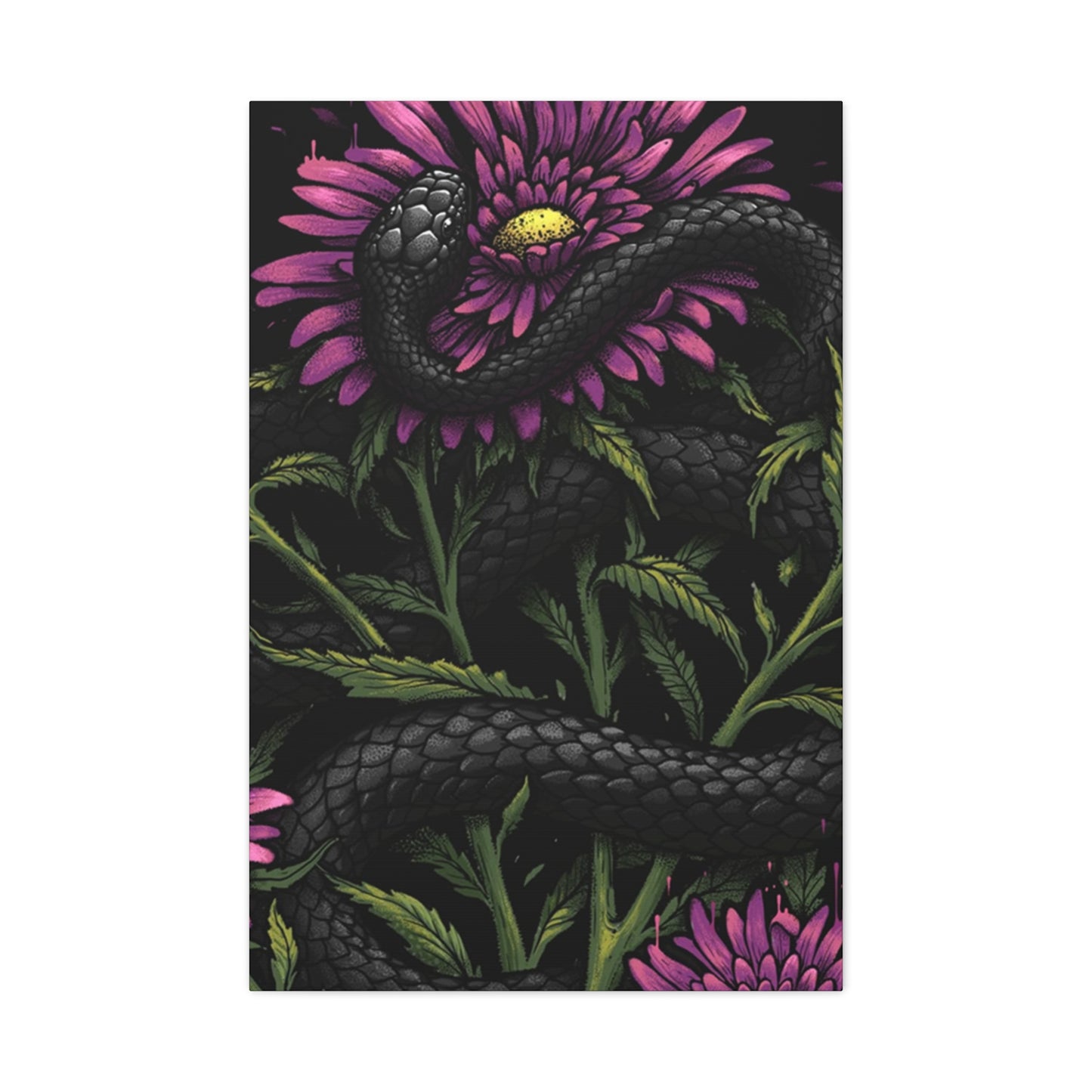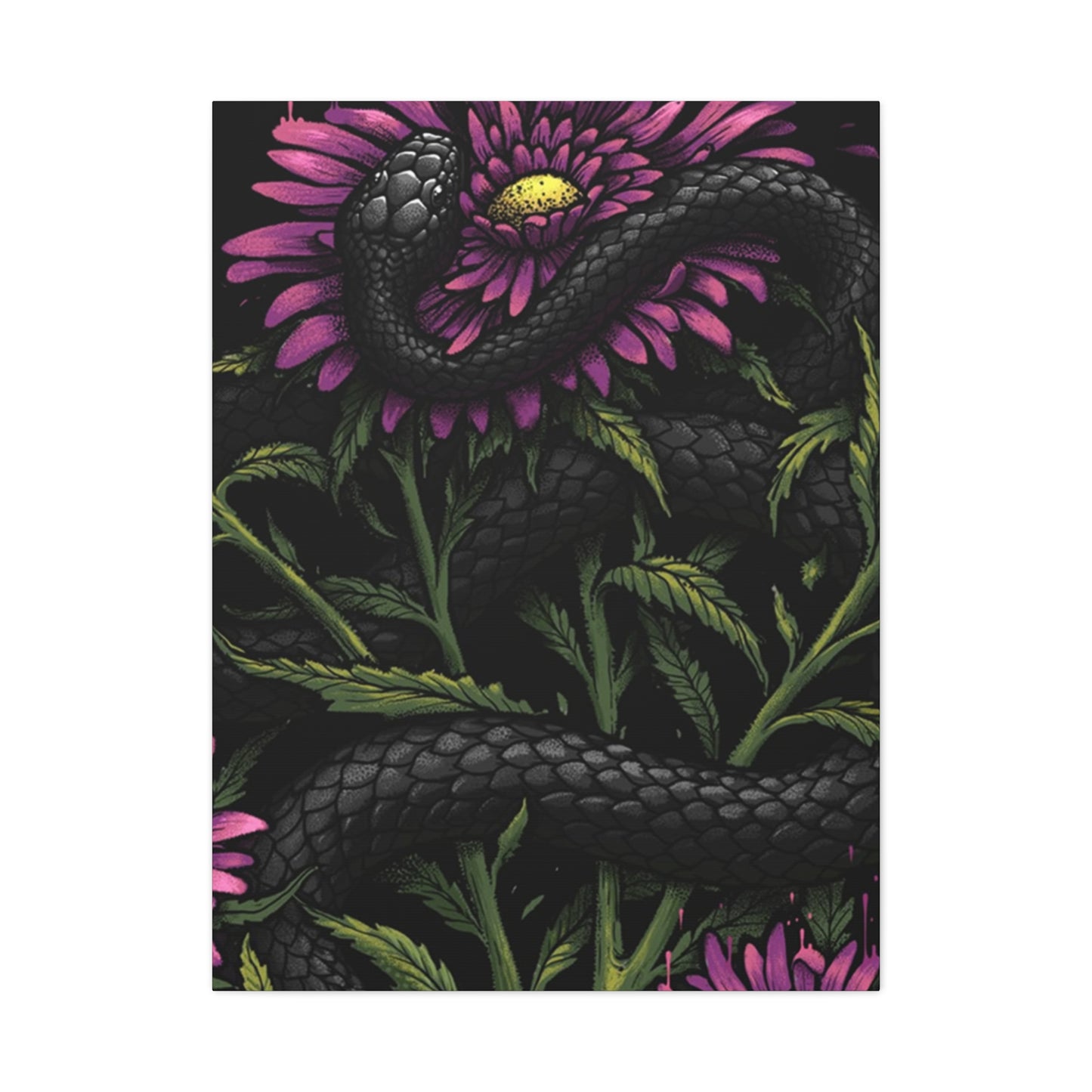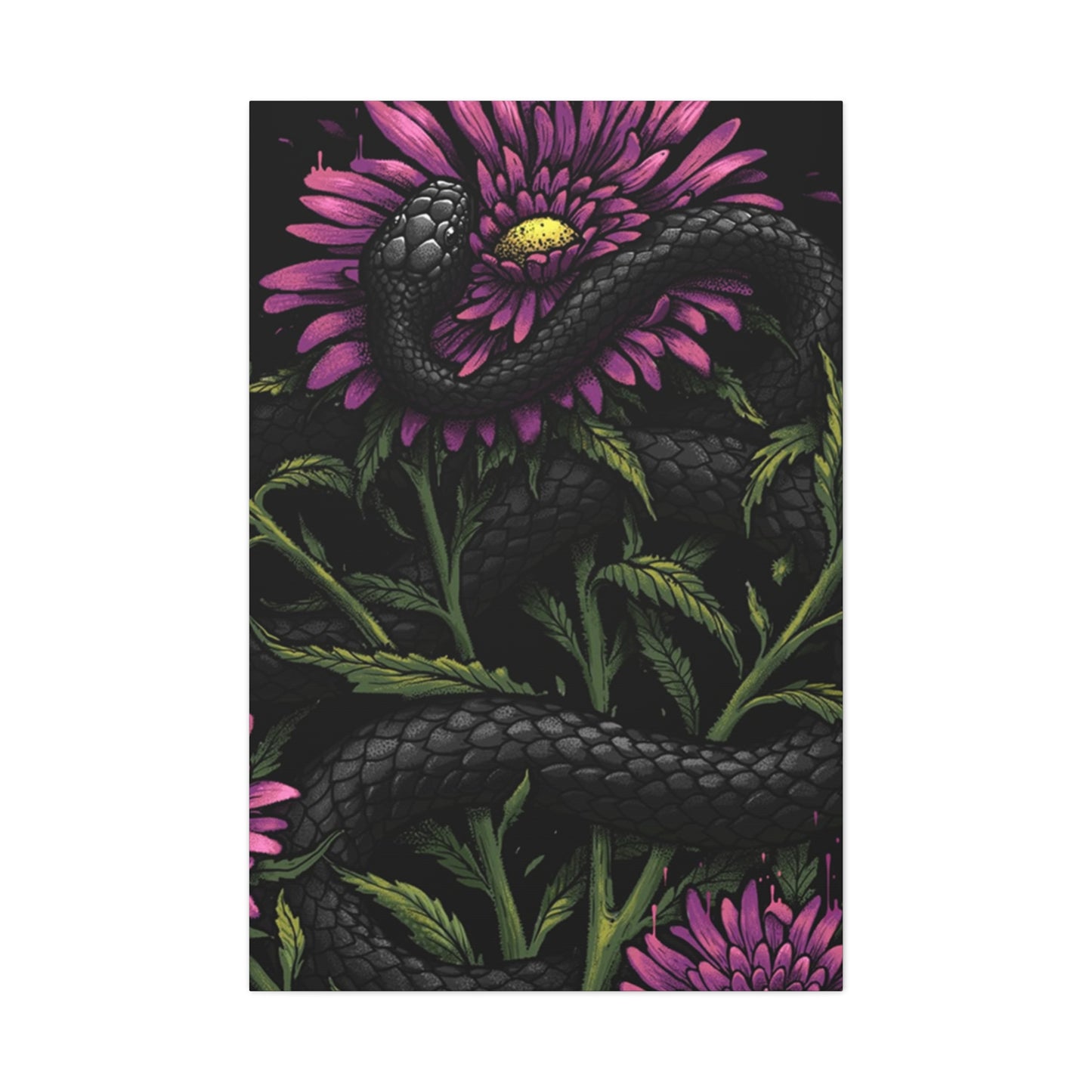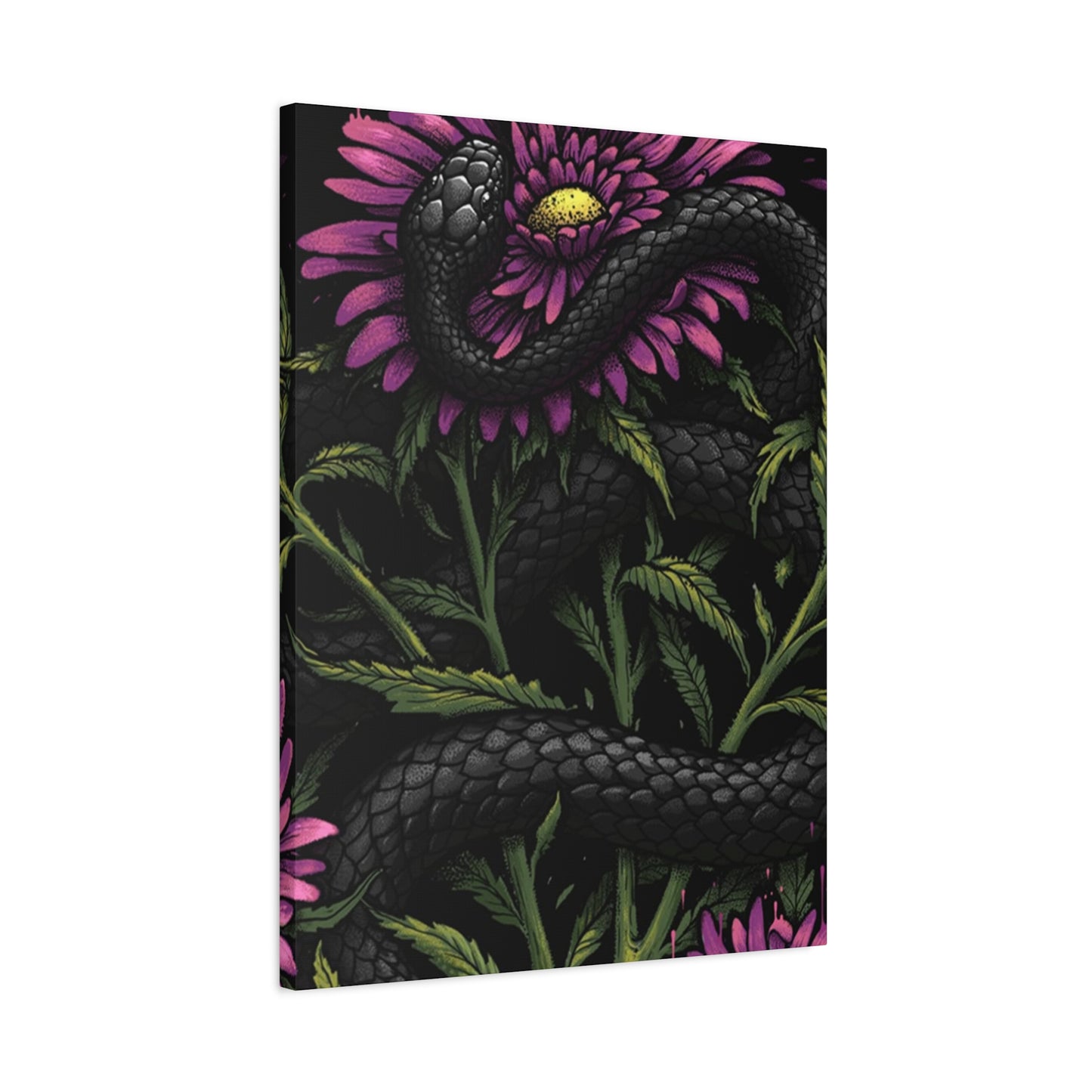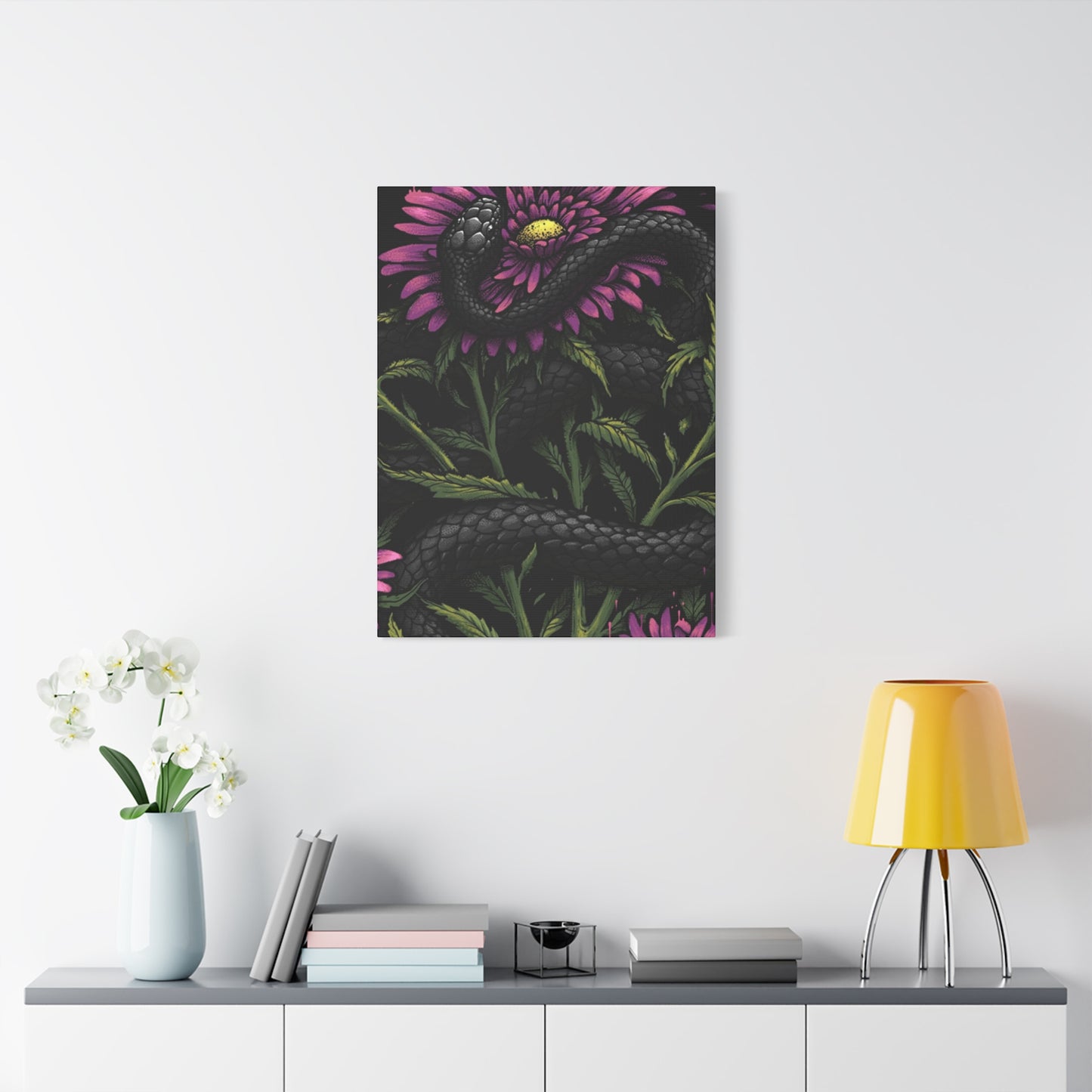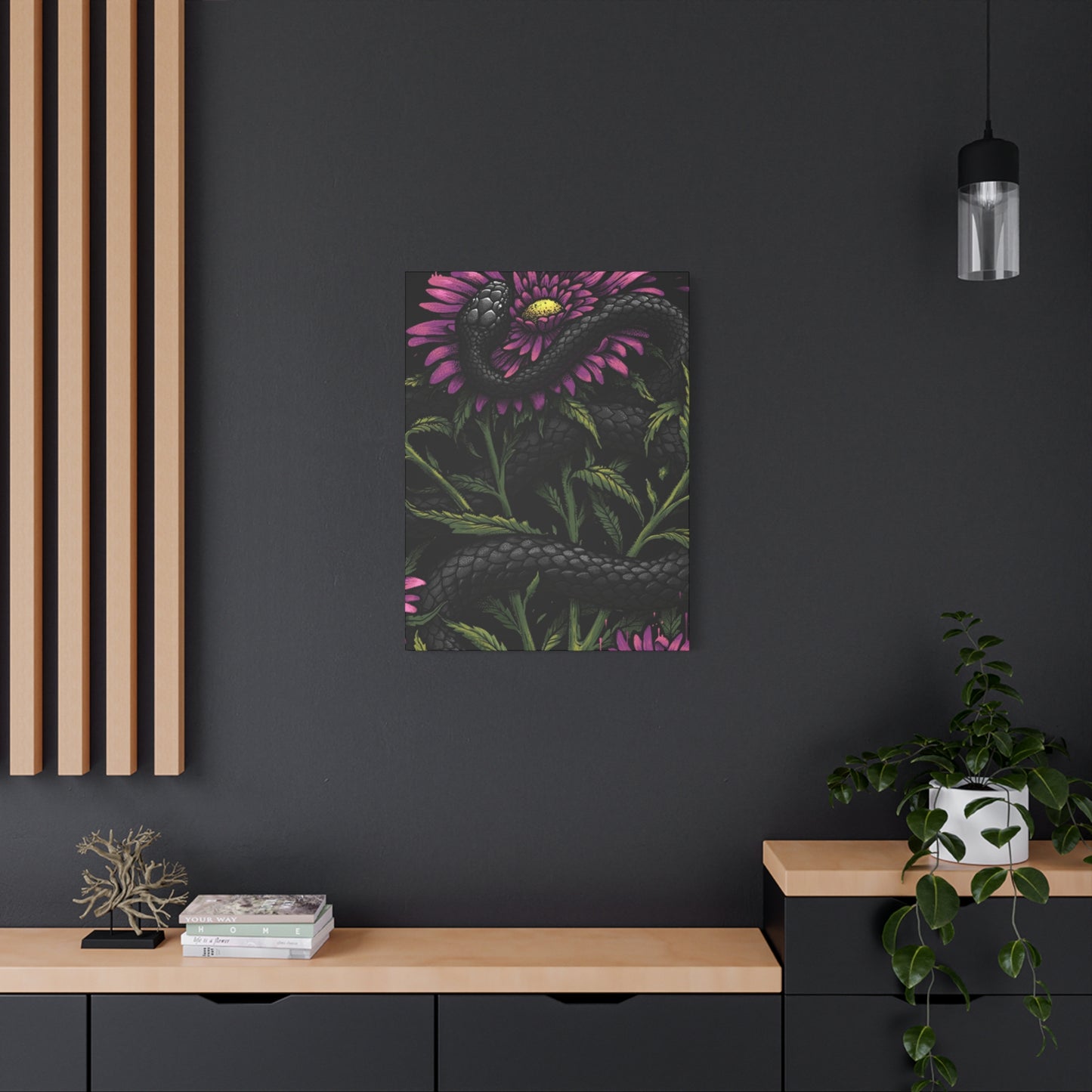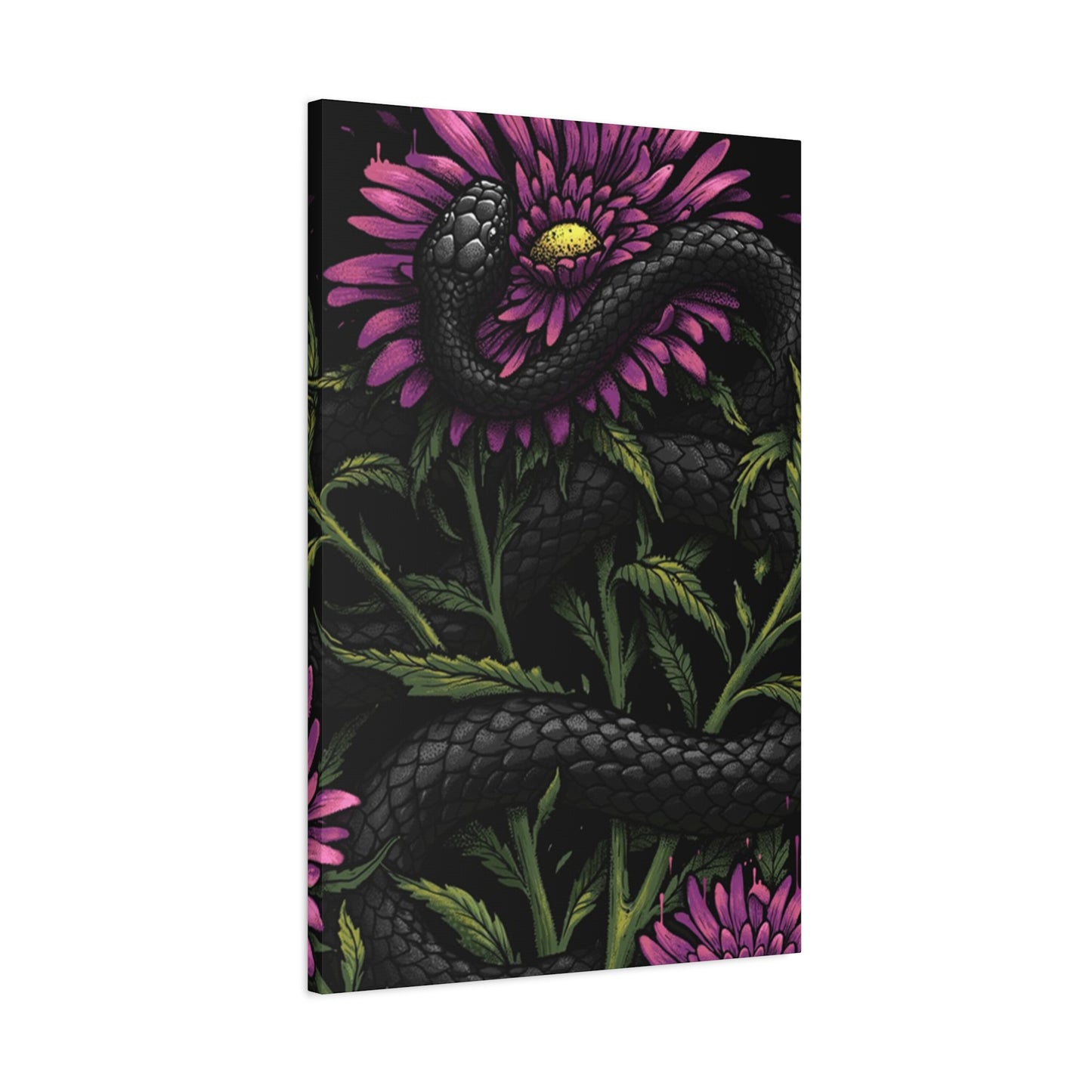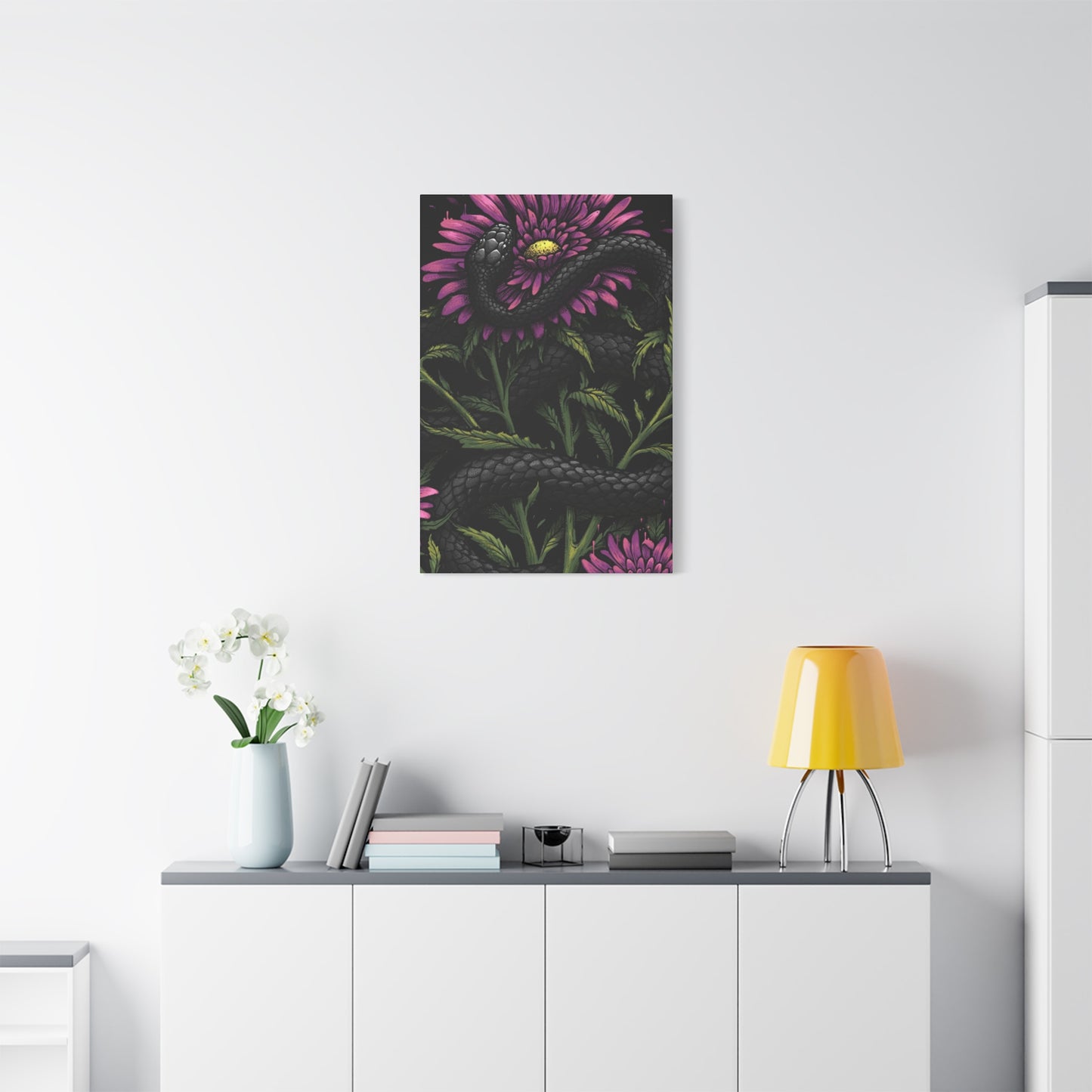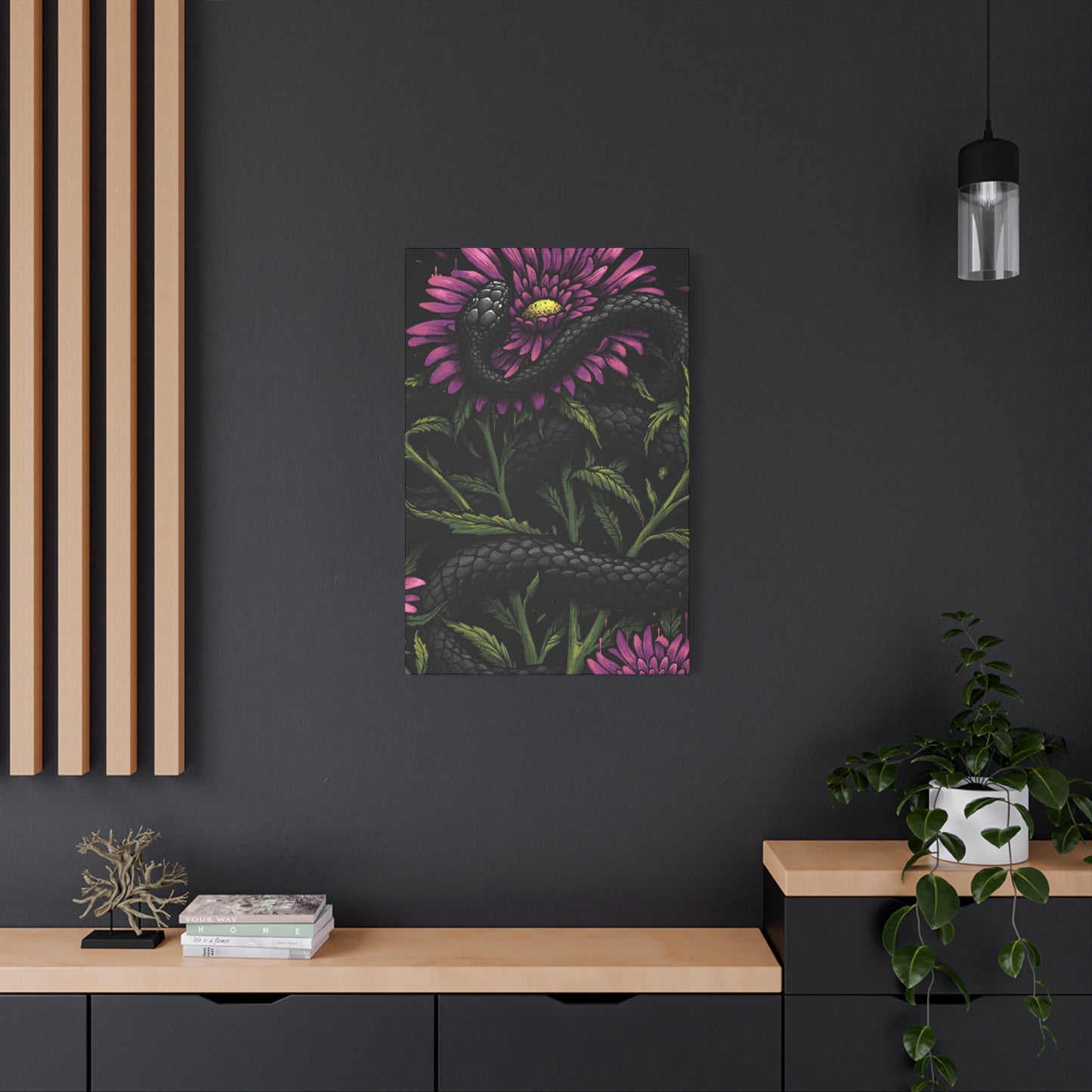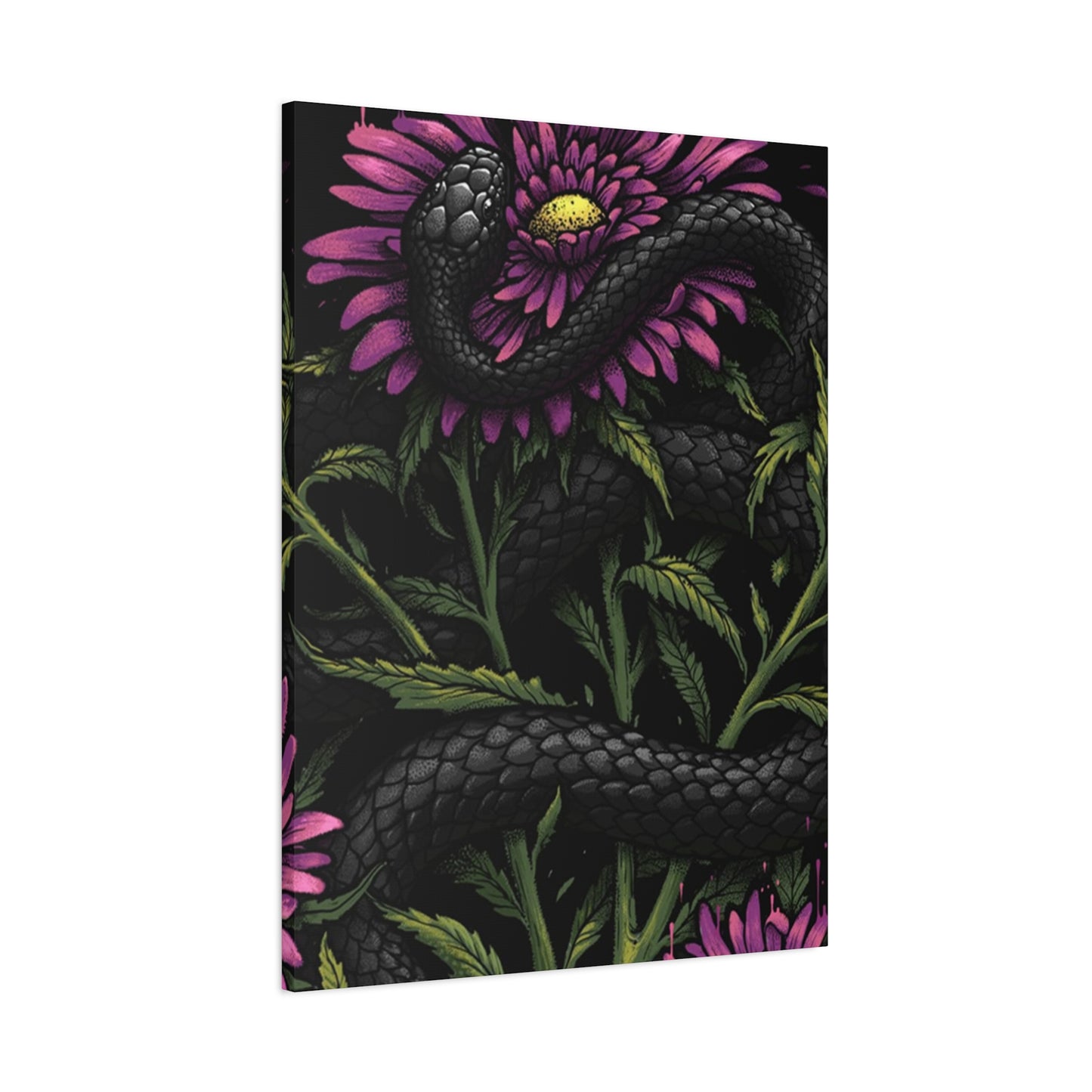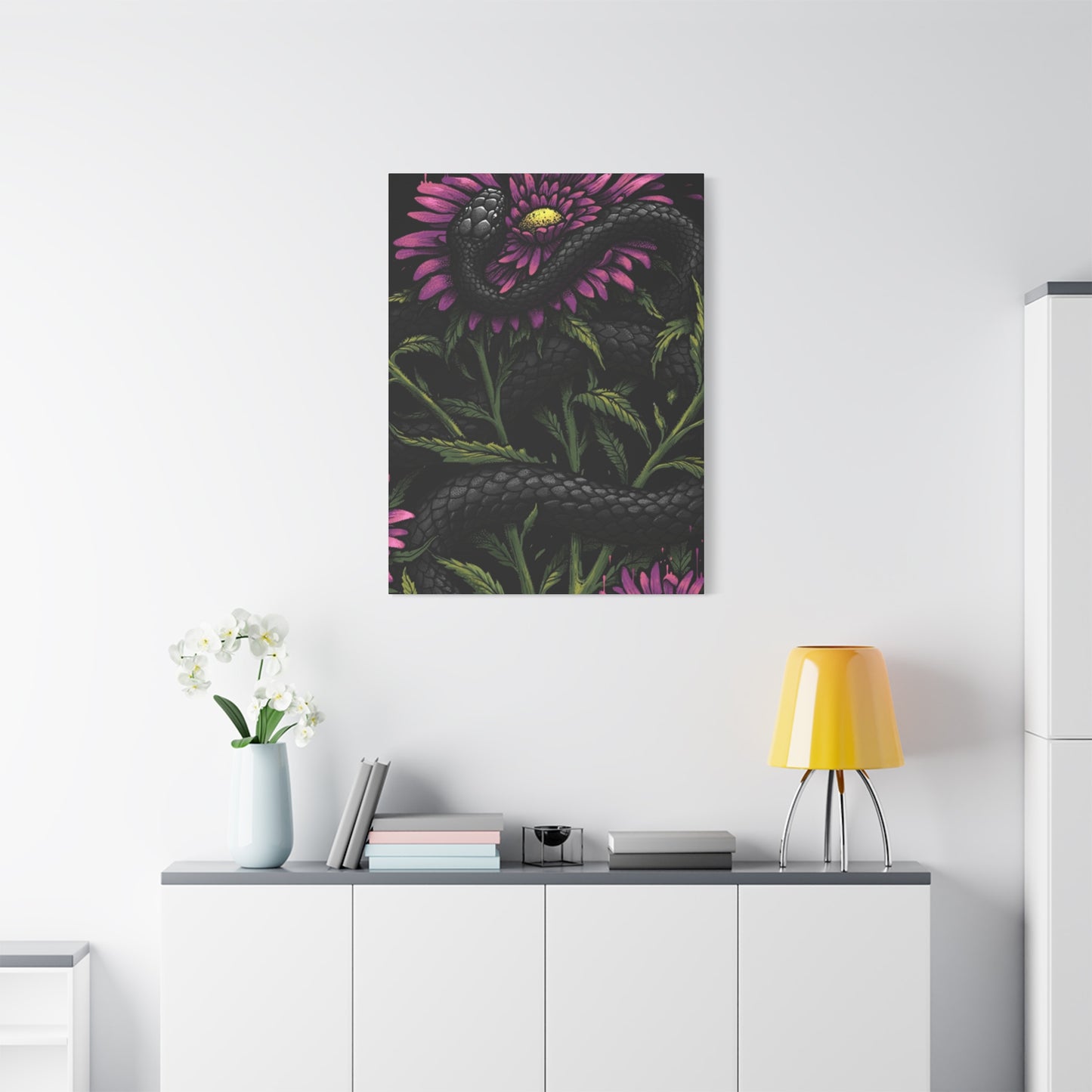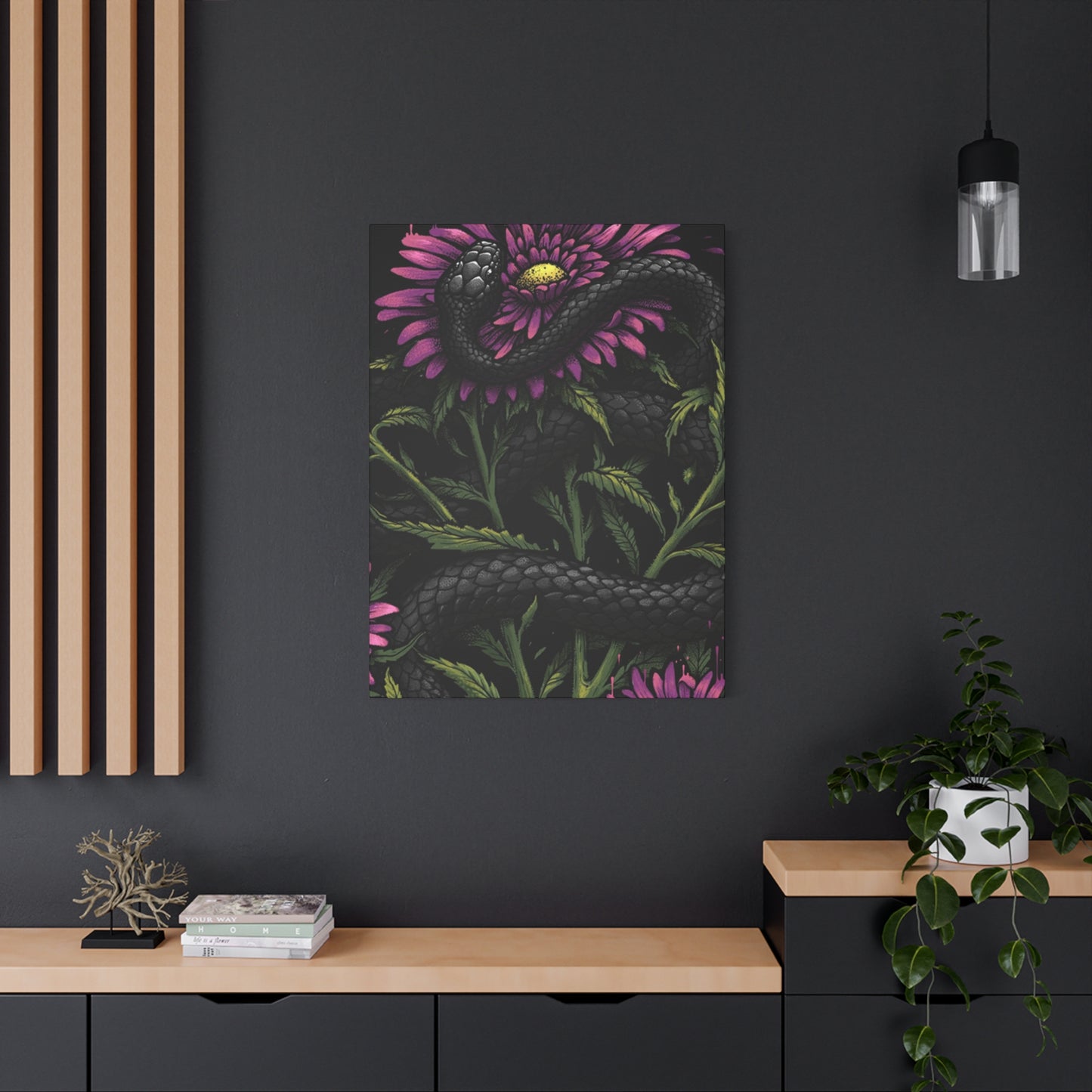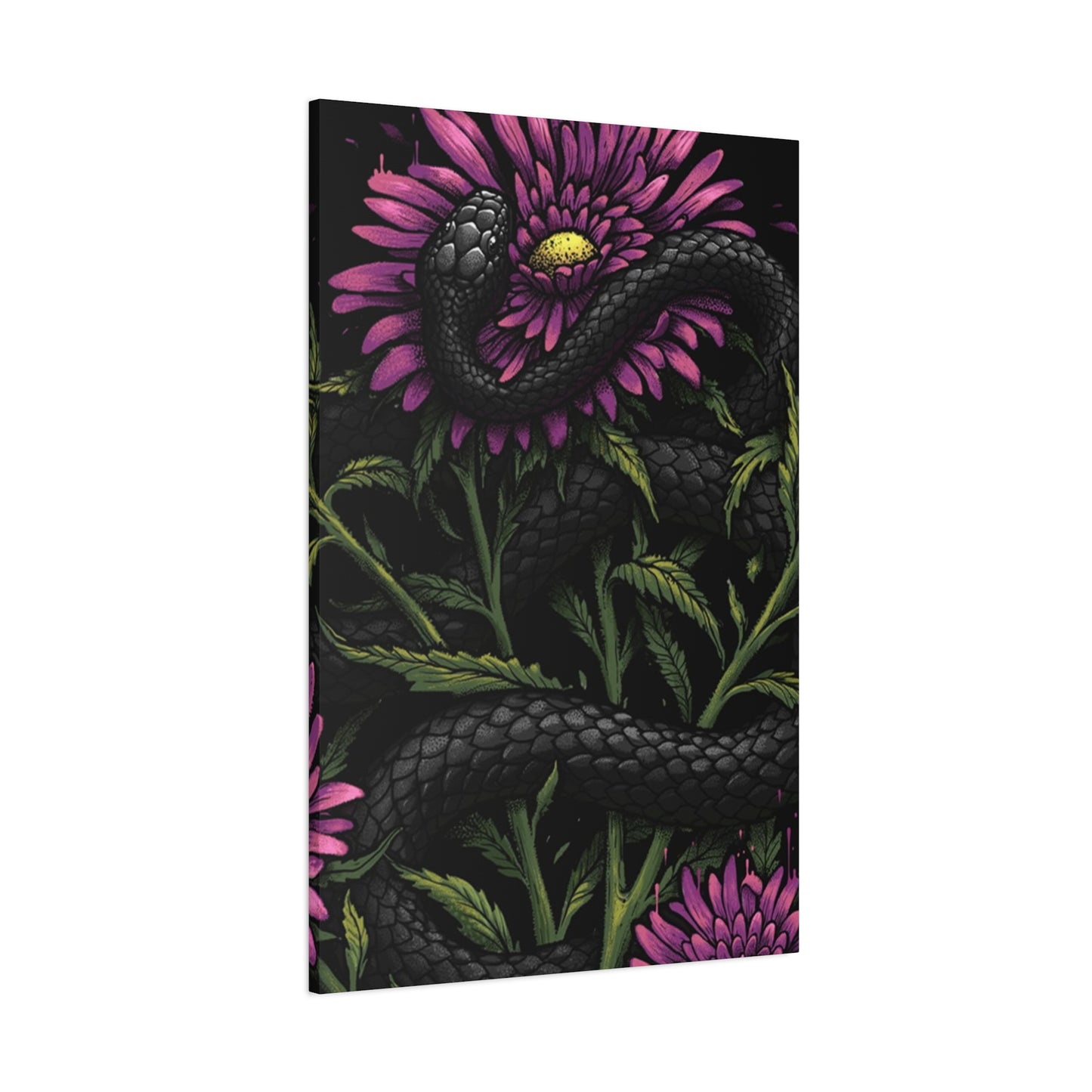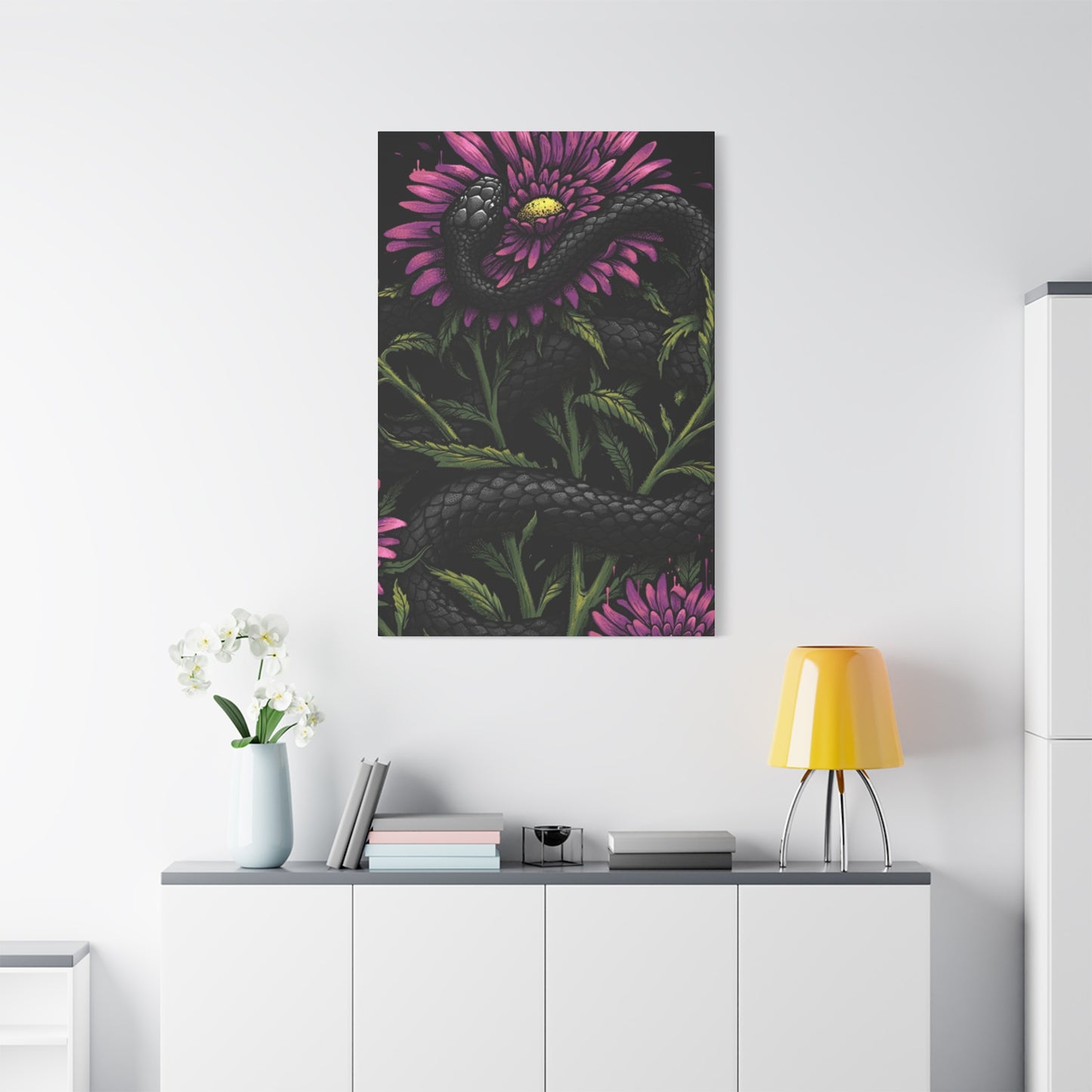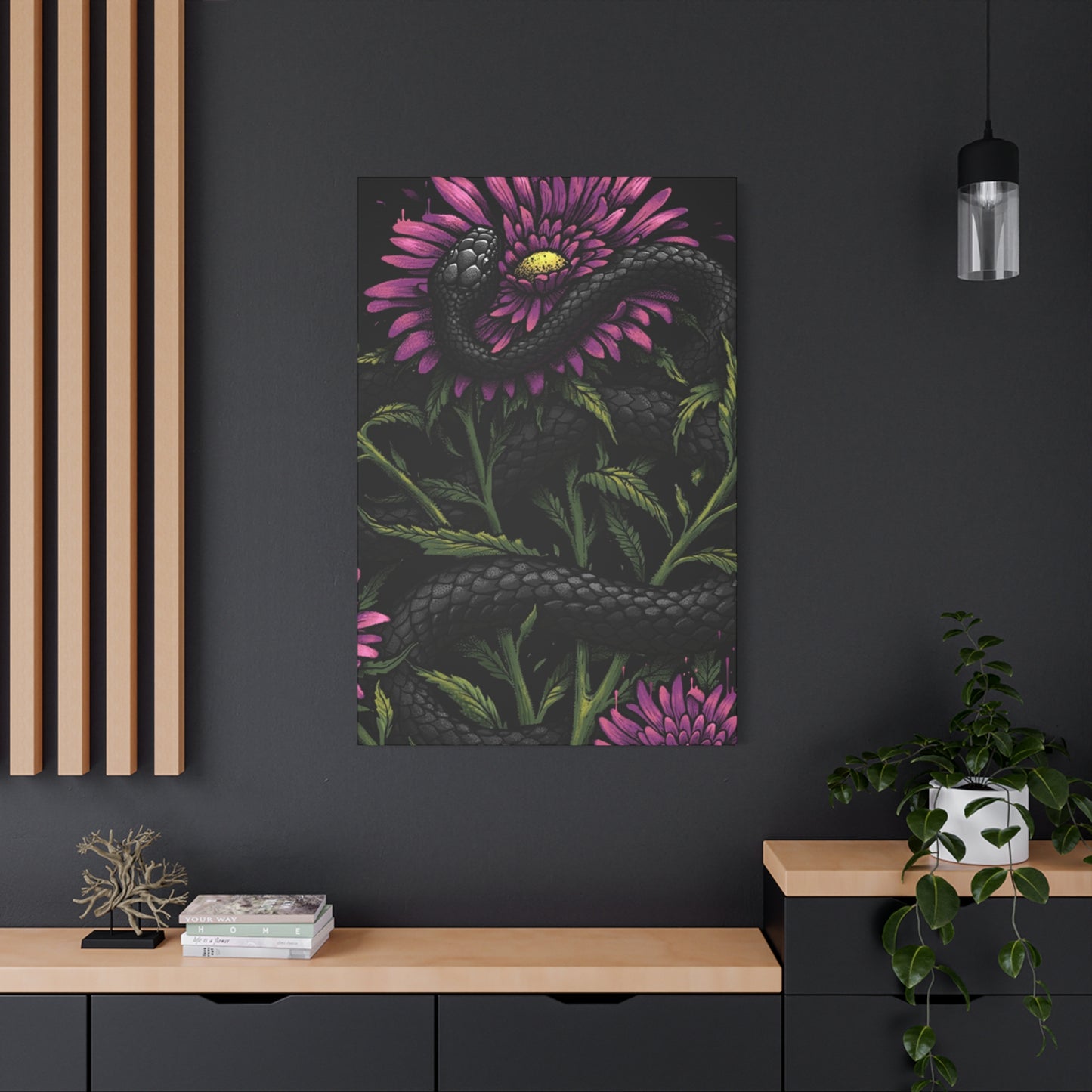Serpentine Artistry: The Captivating World of Snake and flower Wall art Decorations
The mesmerizing fusion of serpentine forms with delicate botanical elements has emerged as one of the most compelling trends in contemporary wall art. This artistic movement transcends traditional boundaries, creating a harmonious balance between danger and beauty, darkness and light. Snake and floral wall decorations represent more than mere aesthetic choices; they embody profound symbolism while delivering stunning visual impact that transforms any living space into an extraordinary sanctuary of artistic expression.
Black Snake Elegance Wall Art
The concept of black snake elegance in wall art represents the pinnacle of sophisticated home decoration. These artistic pieces capture the sleek, sinuous beauty of serpents rendered in deep, rich blacks that command attention while maintaining an air of mysterious refinement. The elegance inherent in these designs stems from their ability to convey power and grace simultaneously, creating visual narratives that speak to our primal fascination with these magnificent creatures.
Black snake wall art pieces often feature serpents in various poses, from coiled positions that suggest potential energy to flowing, undulating forms that seem to move across the canvas. The use of black as the primary color choice creates dramatic contrast against lighter backgrounds, allowing the serpentine forms to emerge with striking clarity and presence. These pieces work exceptionally well in modern and contemporary interior design schemes, where clean lines and bold statements are valued.
The psychological impact of black snake elegance artwork cannot be understated. Black, as a color, represents power, sophistication, and mystery, while the serpent form adds layers of symbolism including transformation, wisdom, and primal energy. When combined, these elements create wall art that not only serves as decoration but also as conversation starters and focal points that draw viewers into deeper contemplation.
Contemporary artists working in this medium often employ various techniques to achieve the desired elegance. Some utilize photorealistic approaches that capture every scale and curve with meticulous detail, while others opt for more abstract interpretations that focus on the essential beauty of serpentine movement. The choice of canvas, print quality, and framing all contribute to the overall impact of these elegant pieces.
Installation considerations for black snake elegance wall art require careful attention to lighting and placement. These pieces often benefit from strategic lighting that enhances their dramatic qualities without overwhelming their subtle details. The surrounding decor should complement rather than compete with the powerful presence of the serpentine imagery, creating a harmonious environment where the artwork can truly shine.
Floral Venom Wall Art
Floral venom wall art represents a fascinating juxtaposition that challenges traditional perceptions of beauty and danger. This artistic concept combines the deadly allure of venomous serpents with the delicate beauty of flowers, creating compositions that are both visually stunning and intellectually provocative. The resulting artworks speak to the duality present in nature, where beauty and danger often coexist in perfect harmony.
The artistic interpretation of floral venom themes requires sophisticated understanding of both botanical and serpentine forms. Artists working in this genre must master the delicate curves of flower petals while simultaneously capturing the powerful, muscular forms of snakes. The challenge lies in creating compositions where both elements complement rather than overwhelm each other, resulting in balanced designs that celebrate the unique characteristics of each component.
Color palettes in floral venom wall art tend to be rich and complex, often featuring deep purples, vibrant reds, and lush greens that evoke both the toxicity associated with venom and the natural beauty of flowering plants. These color choices create emotional responses that range from attraction to apprehension, mirroring our complex relationship with dangerous beauty in the natural world.
The symbolic significance of floral venom artwork extends beyond mere aesthetic appreciation. Flowers have long been associated with life, growth, and beauty, while venom represents danger, transformation, and power. When combined in artistic compositions, these symbols create narratives about the complexity of existence, the beauty found in dangerous things, and the transformative power of embracing both light and dark aspects of life.
Technical execution of floral venom wall art requires mastery of various artistic techniques. The rendering of flower petals demands understanding of light, shadow, and texture to create convincing botanical representations. Similarly, serpentine forms require knowledge of anatomy, movement, and scale patterns to achieve realistic portrayals. The integration of these disparate elements into cohesive compositions represents the highest level of artistic skill.
Serpent in Bloom Canvas Wall Art
Serpent in bloom canvas wall art captures the magical moment where reptilian grace meets botanical splendor. These artistic pieces typically feature serpents intertwined with or surrounded by flowering plants, creating dynamic compositions that celebrate the interconnectedness of all living things. The canvas medium provides an ideal surface for these complex compositions, allowing artists to build layers of color and detail that bring the imagery to life.
The conceptual foundation of serpent in bloom artwork rests on the observation that in nature, serpents often inhabit environments rich with plant life. This natural association provides artists with authentic inspiration for their compositions, ensuring that the resulting artworks feel organic and believable rather than forced or artificial. The bloom aspect adds seasonal significance, suggesting renewal, growth, and the cyclical nature of life.
Canvas as an artistic medium offers unique advantages for serpent in bloom compositions. The texture of canvas allows for rich paint application that can capture both the smooth scales of serpents and the delicate textures of flower petals. This medium also provides durability and longevity, ensuring that these complex artworks maintain their visual impact for years to come.
The compositional challenges inherent in serpent in bloom artwork require careful consideration of balance, rhythm, and visual flow. Serpents naturally create strong linear elements that can guide the viewer's eye through the composition, while flowers provide punctuation points and areas of concentrated visual interest. Successful pieces achieve harmony between these elements while maintaining the individual character of each component.
Color relationships in serpent in bloom canvas art often explore complementary and analogous color schemes that enhance the natural beauty of both elements. Earth tones and natural greens provide grounding for more vibrant floral colors, creating depth and visual hierarchy within the composition. The interplay of warm and cool colors can create emotional resonance that enhances the overall impact of the artwork.
Petals and Scales Wall Art Print
Petals and scales wall art prints represent the fascinating contrast between two of nature's most distinctive textures and forms. This artistic concept celebrates the incredible diversity found in the natural world by highlighting the unique characteristics that make both flowers and serpents remarkable in their own ways. The juxtaposition creates visual tension and interest that captivates viewers and invites closer examination.
The technical challenges of representing both petals and scales in wall art prints require sophisticated printing techniques and high-quality reproduction methods. Petals, with their soft, translucent qualities and subtle color gradations, demand different treatment than scales, which feature hard, geometric patterns and often display iridescent or metallic qualities. Successful prints must capture both textures convincingly while maintaining overall compositional unity.
Print quality considerations for petals and scales artwork include paper selection, ink quality, and reproduction accuracy. Fine art papers with appropriate texture can enhance the visual impact of these detailed compositions, while high-quality inks ensure color accuracy and longevity. The printing process itself must preserve the subtle details that make both petals and scales visually compelling.
The symbolic significance of petals and scales extends into various cultural and personal interpretations. Petals often represent fragility, beauty, and the ephemeral nature of life, while scales suggest protection, adaptation, and endurance. Together, they create narratives about the different strategies life employs to survive and thrive in challenging environments.
Design applications for petals and scales wall art prints are virtually limitless. These pieces work well in botanical-themed rooms, nature-inspired spaces, and contemporary settings where textural contrast is valued. The prints can serve as statement pieces or be grouped with other nature-themed artwork to create gallery walls that celebrate the diversity of natural forms.
The educational value of petals and scales artwork should not be overlooked. These pieces can spark conversations about natural history, evolutionary adaptation, and the incredible diversity of life on Earth. They serve as beautiful reminders of the complex and fascinating world that exists beyond human experience.
Dark Garden Serpent Wall Art
Dark garden serpent wall art explores the mysterious and often overlooked nocturnal world of garden ecosystems. These artistic pieces typically feature serpents in shadowy garden settings, surrounded by plants and flowers that take on different characteristics in low light conditions. The dark theme adds drama and intrigue while highlighting the important ecological role that serpents play in garden environments.
The aesthetic appeal of dark garden serpent artwork lies in its ability to transform familiar garden imagery into something mysterious and compelling. Shadows, moonlight, and the subtle colors of night-blooming plants create atmospheric conditions that enhance the serpentine forms and add layers of visual interest. These pieces often feature rich, deep colors that create mood and emotional resonance.
Garden serpents serve important ecological functions that are often misunderstood or underappreciated. These reptiles help control rodent populations, contribute to nutrient cycling, and serve as both predator and prey in complex garden ecosystems. Dark garden serpent wall art can help viewers develop appreciation for these often-feared creatures while celebrating their natural beauty and ecological importance.
The artistic challenges of creating compelling dark garden serpent artwork include managing limited light conditions, creating depth in shadowy compositions, and maintaining visual interest despite darker color palettes. Artists must master the subtle interplay of light and shadow while ensuring that important details remain visible and engaging.
Compositional strategies for dark garden serpent wall art often rely on selective lighting that highlights key elements while allowing others to recede into shadow. This creates depth and mystery while guiding the viewer's attention through the composition. The contrast between illuminated and shadowed areas can create dramatic effects that enhance the overall impact of the artwork.
The psychological impact of dark garden serpent artwork can be profound, evoking feelings of mystery, contemplation, and connection with the hidden aspects of nature. These pieces invite viewers to consider the secret lives of creatures that share our spaces but remain largely unseen and unappreciated.
Twisted Beauty Wall Art Canvas
Twisted beauty wall art canvas celebrates the concept that true beauty often emerges from complexity, asymmetry, and unconventional forms. This artistic approach embraces the natural tendency of serpents to coil, twist, and curve, using these movements as foundational elements for creating visually striking compositions that challenge traditional notions of beauty and symmetry.
The philosophical underpinnings of twisted beauty artwork suggest that perfection lies not in rigid symmetry but in organic, flowing forms that reflect the natural world's inherent asymmetry. Serpents, with their ability to create complex three-dimensional curves and spirals, provide ideal subjects for exploring these concepts. The resulting artworks often feature dynamic compositions that seem to move and flow even in static form.
Canvas preparation for twisted beauty serpent artwork requires consideration of how the medium will support complex, flowing compositions. The weave and texture of canvas can enhance the sense of movement in serpentine forms, while proper priming ensures that colors remain vibrant and details remain sharp. The durability of canvas makes it an ideal choice for artwork intended to make lasting impressions.
Color theory applications in twisted beauty wall art often explore how different hues and values can enhance the sense of movement and dimensional depth in serpentine forms. Warm colors can advance while cool colors recede, creating the illusion of three-dimensional form on a two-dimensional surface. Gradual color transitions can follow the curves and twists of serpentine bodies, enhancing their sculptural qualities.
The emotional impact of twisted beauty artwork stems from its ability to find grace and elegance in forms that might initially seem challenging or unfamiliar. These pieces can help viewers expand their aesthetic appreciation while developing more nuanced understanding of natural beauty. The dynamic quality of twisted forms can create feelings of energy and movement that enliven any space.
Installation considerations for twisted beauty canvas artwork include placement at eye level where viewers can fully appreciate the complex interplay of forms and movements. Adequate lighting ensures that subtle details and color transitions remain visible, while appropriate spacing allows the dynamic compositions to breathe and maintain their visual impact.
Silent Coil Snake and Flower Wall Art
Silent coil snake and flower wall art explores the concept of potential energy and quiet power that exists in coiled serpentine forms. This artistic theme captures moments of apparent rest that contain tremendous stored energy, similar to coiled springs ready to release their power. The addition of floral elements creates contrast between active growth and patient waiting, resulting in compositions rich with tension and meaning.
The artistic representation of coiled serpents requires deep understanding of serpentine anatomy and behavior. A properly coiled serpent represents perfect efficiency of form, with each curve and spiral serving specific functional purposes. Artists working with this theme must capture not only the visual appearance of coiled forms but also the sense of controlled power they represent.
Floral integration in silent coil artwork often features flowers that complement rather than compete with the serpentine forms. Climbing vines, trailing blooms, or carefully placed individual flowers can enhance the composition without disrupting the sense of focused energy inherent in coiled serpents. The key lies in achieving balance between these different natural elements.
The symbolic significance of silent coil imagery extends into concepts of patience, preparation, and the calm before action. In many cultures, coiled serpents represent wisdom, protection, and the ability to strike swiftly when necessary. The addition of flowers can represent the beauty that emerges from periods of quiet contemplation and patient waiting.
Technical execution of silent coil snake and flower wall art requires mastery of circular and spiral compositions. Creating convincing coiled forms demands understanding of how serpentine bodies wrap around themselves while maintaining proper proportions and anatomical accuracy. The integration of floral elements requires additional compositional skills to achieve visual harmony.
The meditative quality of silent coil artwork makes these pieces particularly suitable for spaces dedicated to relaxation, contemplation, or quiet work. The sense of controlled energy can be inspiring without being overwhelming, while the natural themes provide connection to the broader world beyond human spaces.
Midnight Bloom Wall Art Decor
Midnight bloom wall art decor captures the ethereal beauty of flowers that bloom in darkness, creating magical scenes where nocturnal beauty takes center stage. This artistic theme often features night-blooming flowers such as moonflowers, night-blooming cereus, or evening primroses, creating compositions that celebrate the hidden beauty that emerges when the sun sets and most human activity ceases.
The integration of serpentine elements into midnight bloom compositions adds layers of mystery and natural authenticity. Many serpent species are most active during twilight and nighttime hours, making their inclusion in nocturnal garden scenes both artistically compelling and ecologically accurate. The combination creates artwork that tells stories about the secret life of gardens after dark.
Color palettes for midnight bloom wall art decor typically feature deep blues, purples, and blacks punctuated by the luminous whites and pale yellows of night-blooming flowers. These color choices create atmospheric effects that evoke the mystery and beauty of nighttime gardens while maintaining enough contrast to keep important details visible and engaging.
The technical challenges of creating convincing midnight bloom artwork include managing limited light sources, creating depth in dark compositions, and maintaining color relationships that feel natural despite unusual lighting conditions. Artists must understand how moonlight and artificial light sources affect the appearance of both flowers and serpentine forms.
Lighting considerations for displaying midnight bloom wall art decor can enhance the atmospheric qualities of these pieces. Subtle, indirect lighting can create viewing conditions that complement the nocturnal themes while ensuring that details remain visible. The goal is to create viewing experiences that honor the mysterious qualities inherent in the artwork.
The psychological impact of midnight bloom artwork often includes feelings of wonder, mystery, and connection with the hidden aspects of natural beauty. These pieces can transform ordinary spaces into environments that suggest adventure and discovery, inviting viewers to imagine the secret worlds that exist beyond their daily experience.
Venom Among Flowers Wall Art
Venom among flowers wall art explores the fascinating relationship between deadly beauty and innocent charm, creating compositions that challenge viewers to reconsider their assumptions about danger and safety in the natural world. This artistic theme celebrates the complexity of natural ecosystems where poisonous and venomous creatures often inhabit the same spaces as delicate, beautiful flowers.
The conceptual foundation of venom among flowers artwork rests on ecological reality. Many venomous serpents live in environments rich with flowering plants, creating natural associations that artists can explore and celebrate. These relationships often involve complex interdependencies where each organism plays important roles in maintaining ecosystem balance.
Artistic interpretation of venom among flowers themes requires sophisticated understanding of both toxic and benign natural elements. The challenge lies in creating compositions that accurately represent both dangerous and beautiful aspects while avoiding sensationalism or fear-mongering. The goal is to create appreciation for complexity rather than simple fear or attraction.
Color symbolism in venom among flowers artwork often employs warning colors found in nature alongside the softer hues associated with flowers. Bright reds, vivid yellows, and striking patterns can signal danger while pastels and earth tones represent safety and beauty. The interplay between these color families creates visual tension that enhances compositional interest.
The educational value of venom among flowers wall art cannot be overstated. These pieces can help viewers develop more nuanced understanding of natural systems while appreciating the beauty that exists even in dangerous forms. They serve as reminders that nature operates according to principles that transcend simple human categories of good and bad.
Cultural interpretations of venom among flowers imagery vary widely, with some traditions celebrating the power and mystery of venomous creatures while others focus on their dangerous aspects. Contemporary artwork in this theme often seeks to balance these perspectives, creating pieces that acknowledge both the beauty and the danger inherent in these natural relationships.
Blooming Danger Wall Art Print
Blooming danger wall art prints capture the paradoxical beauty found in potentially hazardous natural situations. This artistic concept explores how danger and beauty often coexist in nature, creating situations where attraction and caution must be balanced. The blooming aspect suggests growth, renewal, and positive change, while the danger element adds excitement and respect for natural power.
The artistic challenges of representing blooming danger include creating visual compositions that convey both attraction and warning without overwhelming viewers with conflicting messages. Successful pieces achieve balance between these opposing forces while maintaining aesthetic appeal and emotional engagement. The key lies in sophisticated use of color, form, and composition to create complex but unified artworks.
Print production considerations for blooming danger wall art include selecting papers and inks that can accurately reproduce both delicate floral details and bold, warning-like elements. The printing process must preserve subtle gradations while maintaining sharp contrasts where needed. Quality control becomes especially important for pieces that rely on precise color relationships to convey their meanings.
Symbolic interpretations of blooming danger imagery often relate to life experiences where growth and risk intersect. These pieces can represent career changes, relationship developments, or personal transformations that involve both exciting possibilities and potential challenges. The natural metaphors provide accessible ways to explore complex emotional and psychological territories.
Display applications for blooming danger wall art prints work well in spaces where conversation and contemplation are valued. These pieces can serve as focal points in living rooms, studies, or offices where their complex messages can be appreciated over time. The prints can also work effectively in groupings that explore related themes of natural complexity and beauty.
The therapeutic potential of blooming danger artwork lies in its ability to help viewers process complex emotions and situations. By providing beautiful representations of challenging concepts, these pieces can offer comfort and perspective during difficult times while celebrating the growth that often emerges from facing dangers with courage and wisdom.
Shadowed Blossom Wall Art Canvas
Shadowed blossom wall art canvas explores the interplay between light and darkness in natural settings, creating compositions where shadows become as important as illuminated areas. This artistic approach recognizes that shadows can enhance beauty rather than diminish it, adding depth, mystery, and visual interest to floral subjects while creating opportunities for serpentine forms to emerge from darkness.
The technical aspects of creating effective shadowed blossom artwork require mastery of chiaroscuro techniques and understanding of how different types of shadows affect the appearance of natural forms. Cast shadows, form shadows, and reflected light all play important roles in creating convincing three-dimensional effects on two-dimensional surfaces.
Canvas selection for shadowed blossom artwork must consider how different textures and preparations will interact with the layered painting techniques often required for effective shadow work. Smooth canvases may be preferred for detailed work, while textured surfaces can add visual interest that complements the complex interplay of light and shadow.
Color theory applications in shadowed blossom art often explore how shadows are rarely simply darker versions of illuminated colors. Shadows contain reflected colors from surrounding surfaces and atmospheric effects that create complex color relationships. Understanding these phenomena allows artists to create more convincing and visually interesting shadow areas.
The emotional impact of shadowed blossom artwork often includes feelings of mystery, contemplation, and appreciation for subtle beauty that might be overlooked in harsh lighting conditions. These pieces can create calming environments while providing visual interest that rewards careful observation and reflection.
Compositional strategies for shadowed blossom wall art often use shadows to create visual pathways that guide viewers through the artwork while revealing hidden elements that emerge from darker areas. The interplay between revealed and concealed elements creates dynamic viewing experiences that change as viewers spend time with the artwork.
Fangs and Flowers Wall Art
Fangs and flowers wall art represents one of the most dramatic expressions of the beauty-danger duality found in nature. This artistic theme directly juxtaposes the delicate, ephemeral beauty of flowers with the sharp, efficient lethality of serpentine fangs, creating compositions that are both beautiful and intellectually challenging. The contrast forces viewers to confront their assumptions about beauty, danger, and the complex relationships between life and death in natural systems.
The anatomical accuracy required for convincing fang representation demands thorough understanding of serpentine dental structure and function. Different species feature varying fang configurations, from the hollow, hinged fangs of vipers to the fixed fangs of elapids. Artists working with this theme must balance scientific accuracy with aesthetic appeal to create pieces that are both educational and visually compelling.
Floral selection for fangs and flowers compositions often favors species with strong symbolic associations or striking visual characteristics that can hold their own against the dramatic presence of exposed fangs. Roses, with their thorns and romantic associations, orchids with their exotic beauty, or lilies with their funereal connections, all provide rich symbolic content that enhances the overall meaning of the compositions.
The psychological impact of fangs and flowers artwork can be profound, evoking simultaneous attraction and apprehension that mirrors our complex relationship with dangerous beauty in all its forms. These pieces can serve as metaphors for seductive but potentially harmful situations, relationships, or choices, providing visual representations of concepts that are difficult to express in words alone.
Technical execution of fangs and flowers wall art requires mastery of both hard and soft forms, sharp details and flowing curves, precise anatomical representation and impressionistic floral beauty. The contrast in techniques needed for each element can create dynamic visual tension that enhances the overall impact of the finished pieces.
Cultural and mythological associations with fangs and flowers imagery draw from traditions worldwide, from the serpent in Eden to the flower-adorned Quetzalcoatl of Mesoamerican cultures. Contemporary interpretations can honor these historical associations while creating new meanings relevant to modern viewers and contemporary concerns.
The Black Serpent Wall Art Design
The black serpent wall art design represents the essence of serpentine power and mystery stripped to its most fundamental elements. This minimalist approach to serpent imagery focuses on form, movement, and presence rather than decorative elements, creating pieces that command attention through their pure expression of serpentine beauty and strength.
The design philosophy behind black serpent wall art often embraces principles of less-is-more aesthetics, where every element serves a specific purpose and unnecessary details are eliminated. This approach can create more powerful visual impact than cluttered compositions, allowing viewers to focus on the essential qualities that make serpentine forms so compelling and mysterious.
Monochromatic design challenges in black serpent wall art include creating visual interest and depth without relying on color variation. Artists must use value relationships, texture, and form to maintain viewer engagement while exploring the full range of visual possibilities within a limited palette. The results can be surprisingly rich and complex despite apparent simplicity.
The symbolic power of black serpent imagery draws from cultural associations with mystery, power, transformation, and the unknown. Black serpents appear in mythologies worldwide as symbols of wisdom, danger, rebirth, and primal force. Contemporary interpretations can tap into these deep symbolic roots while creating new meanings for modern contexts.
Installation considerations for black serpent wall art design often favor clean, uncluttered environments where the powerful simplicity of the imagery can be fully appreciated. These pieces work particularly well in modern and contemporary settings where bold, simple statements are valued over decorative complexity.
The versatility of black serpent design allows for applications ranging from small, intimate pieces suitable for personal spaces to large-scale installations that can transform entire rooms. The scalability of these designs makes them suitable for various architectural contexts while maintaining their essential impact and meaning.
Mystic Bloom Snake Wall Art
Mystic bloom snake wall art combines serpentine imagery with flowering elements that seem to exist beyond ordinary reality, creating compositions that suggest magical or supernatural dimensions. This artistic theme explores the liminal spaces where natural beauty transcends ordinary experience, inviting viewers to consider possibilities beyond everyday perception.
The mystical elements in these compositions often include ethereal lighting effects, unusual color combinations, or impossible spatial relationships that create dream-like or visionary qualities. These artistic choices can transform familiar natural elements into something extraordinary and otherworldly while maintaining enough connection to reality to remain believable and engaging.
Serpentine forms in mystic bloom artwork often feature enhanced or exaggerated characteristics that emphasize their mythological and symbolic associations. Scales might shimmer with otherworldly iridescence, eyes might glow with inner light, or bodies might seem to flow like liquid energy rather than solid flesh. These enhancements create magical realism that enhances emotional impact.
Floral elements in mystic bloom compositions often feature impossible colors, glowing petals, or growth patterns that defy natural laws while remaining recognizably floral in their essential characteristics. These artistic liberties can create sense of wonder and magic that transforms ordinary flowers into something transcendent and inspiring.
The spiritual dimensions of mystic bloom snake wall art often draw from various esoteric and religious traditions that recognize serpents as symbols of wisdom, transformation, and spiritual power. The flowering elements can represent spiritual growth, enlightenment, or the blossoming of consciousness, creating artwork that speaks to deep human aspirations and experiences.
Contemporary applications of mystic bloom imagery can serve various purposes, from meditation aids to conversation pieces that spark discussions about spirituality, consciousness, and the mysterious aspects of existence. These pieces can create environments that support contemplation, creativity, and spiritual exploration.
Dark Grace Floral Snake Wall Art
Dark grace floral snake wall art explores the concept that true elegance often emerges from the integration of seemingly opposing forces. This artistic theme celebrates the sophisticated beauty that arises when dangerous serpentine power combines with delicate floral grace, creating compositions that are both darkly mysterious and undeniably beautiful.
The aesthetic philosophy behind dark grace artwork suggests that the highest forms of beauty emerge from complexity rather than simplicity, from tension rather than harmony, and from the careful balance of contrasting elements rather than the dominance of any single characteristic. This approach creates artwork that rewards careful viewing and deep contemplation.
Color palette development for dark grace floral snake wall art typically features rich, deep tones punctuated by carefully chosen highlights that create focal points and guide viewer attention. The darkness provides sophisticated backdrop that allows both serpentine and floral elements to emerge with dramatic clarity while maintaining overall compositional unity.
The grace element in these compositions often emerges from careful attention to line quality, proportional relationships, and the flowing integration of different forms. Grace, in this context, represents not delicacy but rather the effortless strength and perfect balance that characterizes truly masterful artistic expression.
Floral selection for dark grace compositions often favors species with strong architectural qualities or dramatic color characteristics that can maintain visual presence alongside powerful serpentine forms. Calla lilies, bird of paradise flowers, or anthurium might provide the structural strength needed to balance serpentine curves and coils.
The psychological impact of dark grace floral snake wall art often includes feelings of sophisticated appreciation for complex beauty that transcends simple categories. These pieces can appeal to viewers who appreciate art that challenges conventional expectations while delivering undeniable visual pleasure and emotional engagement.
Serpentine Color Theory and Visual Psychology
The successful creation of serpent and floral wall art requires sophisticated understanding of color theory and its psychological effects on viewers. Different color combinations can dramatically alter the emotional impact and symbolic meaning of serpentine imagery, making color selection one of the most critical decisions in the artistic process. Warm colors like reds and oranges can enhance the sense of danger and energy in serpent imagery, while cool blues and greens can emphasize mystery and otherworldly qualities.
The psychology of color perception plays crucial role in how viewers respond to serpent and floral combinations. Red flowers paired with dark serpentine forms can create sense of passionate danger, while pale flowers with silvery serpents might suggest ethereal beauty or supernatural encounter. Understanding these relationships allows artists to craft specific emotional responses and guide viewer interpretation of their work.
Cultural color associations vary significantly across different societies and traditions, adding layers of complexity to color selection in serpent and floral artwork. What represents good fortune in one culture might symbolize danger in another, making it important for artists to consider their intended audience when making color choices. Contemporary artists often play with these associations, creating pieces that challenge or subvert traditional color symbolism.
The technical aspects of color reproduction in wall art prints require consideration of how different printing methods and materials affect color accuracy and longevity. Digital prints, lithographs, and giclée prints each have specific characteristics that can enhance or diminish certain color relationships. Artists must understand these limitations to ensure their color intentions are properly realized in the final artwork.
Color harmony principles apply directly to serpent and floral compositions, where successful pieces often employ complementary, analogous, or triadic color schemes that create visual cohesion while maintaining interest and excitement. The natural colors found in serpents and flowers provide rich palette options that can support various harmonic approaches while maintaining realistic believability.
The emotional resonance of color in serpent and floral wall art extends beyond simple aesthetic preference to deeper psychological and even physiological responses. Certain color combinations can create feelings of calm or excitement, comfort or unease, familiarity or strangeness. Masterful artists learn to orchestrate these responses to enhance the overall impact of their work.
Compositional Strategies for Snake and Flower Art
Creating compelling compositions that successfully integrate serpentine and floral elements requires mastery of fundamental design principles adapted to the unique challenges these subjects present. The linear nature of serpent forms creates strong directional forces that must be balanced against the more radial or clustered organization typical of floral arrangements. Successful compositions find ways to make these different organizational principles work together rather than compete for viewer attention.
The rule of thirds applies differently to serpent and flower compositions than to more traditional landscape or portrait subjects. Serpentine curves can create their own grid systems that divide the picture plane in unique ways, while flower clusters can serve as focal points that anchor these flowing compositions. Artists must learn to adapt classical compositional rules to accommodate the specific requirements of these natural forms.
Balance in serpent and floral compositions often involves managing the visual weight of different elements to create stability without sacrificing dynamism. A large, coiled serpent might be balanced by a cluster of bright flowers, while a trailing vine of blossoms might require a smaller but more dramatically positioned snake to achieve compositional equilibrium. The key lies in understanding how different elements contribute to overall visual weight.
Movement and rhythm in these compositions often emerge from the natural characteristics of the subjects themselves. Serpentine curves create inherent movement that can be enhanced or moderated through careful positioning and relationship to other elements. Floral elements can provide punctuation points that create rhythmic patterns, while their growth directions can either reinforce or counterpoint serpentine movement.
Depth creation in snake and flower wall art requires sophisticated use of overlapping, size variation, color temperature, and detail density to create convincing three-dimensional effects. Serpents coiling through floral arrangements provide natural opportunities for overlapping elements that enhance depth perception, while careful attention to atmospheric perspective can create sense of space that extends beyond the picture plane.
The focal hierarchy in successful compositions guides viewer attention through the artwork in planned sequences that reveal important elements in optimal order. Primary focal points might feature dramatic encounters between serpent and flower, while secondary focal points provide resting places for the eye and opportunities to discover additional details and relationships.
Material Considerations for Wall Art Production
The choice of materials for serpent and floral wall art significantly impacts both the visual quality and longevity of the finished pieces. Canvas remains a popular choice for its texture and durability, but different canvas weights and weaves can dramatically affect how paint adheres and how details appear in the final work. Heavy canvas provides stability for detailed work, while lighter weights might be preferred for pieces that emphasize flowing, gestural qualities.
Paper selection for prints requires consideration of how different surfaces interact with various ink types and printing methods. Smooth papers can enhance fine detail reproduction, while textured surfaces can add visual interest that complements the organic nature of serpent and flower subjects. Acid-free papers ensure longevity, while different brightness levels can affect color reproduction and overall mood.
Ink quality becomes particularly important for serpent and floral wall art because these subjects often feature subtle color transitions and complex textural details that require accurate reproduction. Archival inks resist fading and color shifting over time, preserving the artist's original color intentions for decades. Different ink formulations can also affect how colors appear on various paper types.
Frame selection for serpent and floral wall art should enhance rather than compete with the artwork itself. Natural wood frames can complement the organic themes, while metal frames might provide contemporary contrast that enhances modern interpretations. The frame color, width, and style all contribute to the overall presentation and can significantly affect how the artwork is perceived.
Protective measures for wall art include UV-resistant glazing that prevents color fading from sunlight exposure, moisture barriers that protect against humidity changes, and proper mounting techniques that prevent warping or other physical damage. These considerations become particularly important for valuable or sentimental pieces that are intended to last for generations.
Installation hardware must be appropriate for the weight and size of the finished pieces while providing secure mounting that protects both the artwork and the wall. Professional installation might be recommended for large or valuable pieces, while smaller works can often be safely installed by the owner following proper procedures.
Environmental and Ecological Themes
Serpent and floral wall art can serve important educational and advocacy functions by highlighting environmental themes and ecological relationships that are often overlooked or misunderstood. Many serpent species play crucial roles in ecosystem health by controlling rodent populations and serving as both predator and prey in complex food webs. Artwork that depicts these relationships can help viewers develop greater appreciation for often-feared creatures.
The ecological interactions between serpents and flowering plants create rich subject matter for artists interested in environmental themes. Some serpents are important pollinators, while others create disturbances that promote plant diversity and growth. These relationships demonstrate the interconnectedness of natural systems and can inspire artwork that celebrates ecological complexity rather than simplified nature imagery.
Climate change impacts on serpent and flower populations provide contemporary relevance for environmental artwork. Rising temperatures affect flowering times, serpent activity patterns, and the geographic ranges of both groups. Artists can create pieces that document these changes while celebrating the resilience and adaptability of natural systems.
Habitat conservation messages can be effectively communicated through serpent and floral wall art that depicts threatened ecosystems or species. Beautiful artwork can engage viewers emotionally while conveying important information about conservation needs and opportunities. These pieces can serve as fundraising tools for environmental organizations while providing aesthetic pleasure.
The concept of coevolution, where serpents and plants evolve together over long time periods, provides fascinating subject matter for scientifically informed artwork. These evolutionary relationships create natural partnerships that can inspire artistic compositions celebrating the deep connections between different forms of life.
Urban ecology themes can explore how serpents and flowers adapt to city environments, creating new relationships and opportunities in modified landscapes. This contemporary approach to environmental art can help urban dwellers connect with nature while recognizing the wildness that exists even in highly developed areas.
Conclusion
Snake and flower wall art decorations offer a unique fusion of beauty, symbolism, and artistic expression, making them a compelling choice for modern interior design. By combining the sinuous forms of serpents with the delicate elegance of flowers, these artworks create a dynamic interplay of movement, contrast, and harmony. This combination allows spaces to feel both visually engaging and emotionally resonant, transforming walls from simple backdrops into captivating storytelling elements.
The symbolic depth of snake and flower motifs adds layers of meaning to any interior. Snakes, often representing transformation, wisdom, and resilience, paired with flowers that symbolize growth, vitality, and fleeting beauty, provide a narrative that celebrates the balance of strength and delicacy. Displaying such pieces in living rooms, bedrooms, or creative spaces not only enhances the visual aesthetic but also inspires reflection, curiosity, and a sense of personal connection to the art.
From an interior design perspective, these artworks are versatile and adaptable. Bold, detailed prints can serve as statement pieces that anchor a room, while smaller, more subtle compositions can be integrated into gallery walls or mixed with other decorative elements. Their color palettes—ranging from earthy tones and vibrant florals to dramatic contrasts—allow for seamless incorporation into contemporary, eclectic, or even traditional design schemes.
Ultimately, snake and flower wall art decorations transcend mere ornamentation. They elevate interior spaces by merging artistic beauty with symbolic richness, creating environments that are both stylish and meaningful. Incorporating serpentine artistry into home décor transforms ordinary walls into evocative canvases that captivate the eye, engage the mind, and inspire a deeper appreciation for the delicate balance between power and elegance in the natural world.

















